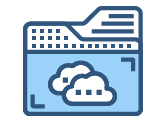CLOUD COMPUTING
Moremicro can manage your cloud services, giving you complete peace of mind.
POWER YOUR BUSINESS SECURELY
WITH CLOUD COMPUTING
Moremicro can manage your cloud services, giving you complete peace of mind. Whatever your business needs and challenges, we can provide you with a bespoke, flexible and scalable solution.
SERVICES OVER THE INTERNET
WHAT IS CLOUD COMPUTING?
Cloud computing is the delivery of computing services such as software, servers, databases, networking, storage and intelligence over the Internet. It offers businesses great flexibility, efficiency, security and benefits and can support growing business needs.

PUBLIC / PRIVATE / HYBRID
WHAT ARE THE TYPES OF CLOUD COMPUTING?
PUBLIC CLOUD
Public clouds (for example Microsoft Azure, Google Cloud or Amazon Web Services (AWS) allow users to set up accounts quickly without the need to buy hardware or software. Users can access their cloud via a web browser and have flexibility around what subscription they wish to purchase depending on their needs, such as a monthly or yearly package. A public cloud is ideal for personal usage.
PRIVATE CLOUD
A private cloud uses a private network exclusively and offers businesses great security and control. It can be hosted onsite in an organisation’s data center or hosted offsite with a third-party provider.
Organisations can purchase a variety of storage and data packages with a private cloud and can build a unique cloud to suit their needs. Most businesses opt for a private cloud when they require complete control over their infrastructure, typically to fulfil business security or compliance measures.
HYBRID CLOUD
A hybrid cloud combines both public and private clouds and offers businesses more flexibility, agility and security.
By combining services and data from two clouds, businesses can create a unified, scalable and well controlled computing environment.
IaaS / PaaS / SaaS
WHAT ARE THE TYPES OF CLOUD SERVICES?
INFRASTRUCTURE AS A SERVICE (IaaS)
At a basic level, Infrastructure as a Service (Iaas) offers clients computing services such as networking and storage on a pay as you go basis.
PLATFORM AS A SERVICE (PaaS)
Platform as a Service (PaaS) allows developers to deliver, test and manage software applications, such as creating web or mobile apps.
SOFTWARE AS A SERVICE (SaaS)
Software as a service is typically known as an “on-demand” software whereby the software is licensed on a subscription basis and delivered through a web browser. Popular examples include Microsoft Office 365 (Office 365), Salesforce and Google’s G Suite.
Benefits of cloud computing

COST
Eliminate the costs of buying or leasing expensive hardware, servers and software by switching to online cloud computing.

SPEED
Cloud computing allows you to deploy your services quickly in just a few clicks and can be accessed remotely anywhere providing you have an internet connection and login credentials.

SECURITY
Cloud offers great security due to its advanced security protocols in place to protect unauthorised access to business data and systems.

SCALABILITY
Cloud technology can be deployed instantly to help businesses scale up or down when needed.

RELIABILITY
Quick, automated data back-ups and disaster recovery gives businesses complete peace of mind.

PRODUCTIVITY
As a centralised solution, cloud allows businesses to operate efficiently by reducing long term costs and time-consuming IT tasks, allowing businesses to allocate resources to business needs.

TRIPLE RESILIENCE
Services will be held across three data centres, across the UK and EU. Should a problem ever arise, we’ll be able to have you up and running quickly by restoring your back-up cloud.
CLOUD MIGRATION
Migrate with confidence
Cloud migration is the process of transferring data and systems to a public, private or hybrid cloud computing environment. It has many benefits depending on business goals, technical and functional needs. Below we’ve outlined the four key stages of cloud migration.
1
Assessment
An onsite assessment is carried out by Moremicro’s cloud deployment team of the current infrastructure, security requirements and purpose of migration.
2
Mapping
A pivotal part of migration, stage two involves careful planning, restructuring and designing. We prepare your on-premises environment to ensure its ready for a test migration.
3
Stage, test & optimise
During stage three, we run a test migration to make sure everything is working as expected and that all data and systems have successfully migrated across.
4
Complete migration
Once migration is complete, frequent optimisation and tests are key to enable the efficiency of cloud use.
GET IN TOUCH WITH US
Get the help you need 24/7 - We’re here for you every step of the way

